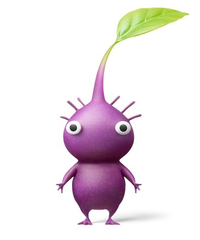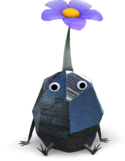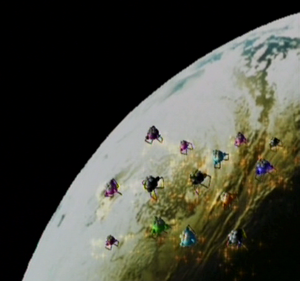Pikmin family: Difference between revisions
m (remove speculation) |
m (Linked to Enemy.) |
||
| Line 103: | Line 103: | ||
==Habits== | ==Habits== | ||
[[image:IdlePikmin.jpg|thumb|90px|An idle Pikmin.]] | [[image:IdlePikmin.jpg|thumb|90px|An idle Pikmin.]] | ||
Pikmin following [[leader]]s are prone to stumbling every now and then, and occasionally fall over completely, in both [[Pikmin games|''Pikmin'' games]]. This happens much more frequently in ''[[Pikmin]]'', and, further complicated by a mass of 100 Pikmin walking together, can sometimes pose a serious problem, reducing general maneuverability. In ''[[Pikmin 2]]'', Pikmin trip much less frequently, but still stumble often if directed to switch positions suddenly. During a retreat from a [[ | Pikmin following [[leader]]s are prone to stumbling every now and then, and occasionally fall over completely, in both [[Pikmin games|''Pikmin'' games]]. This happens much more frequently in ''[[Pikmin]]'', and, further complicated by a mass of 100 Pikmin walking together, can sometimes pose a serious problem, reducing general maneuverability. In ''[[Pikmin 2]]'', Pikmin trip much less frequently, but still stumble often if directed to switch positions suddenly. During a retreat from a [[Enemy|beast]], a Pikmin that trips is likely to be eaten or squashed by the creature; this is especially aggravating during zero death runs. Sometimes, it may be hard to notice if a Pikmin trips, leading to lone Pikmin becoming separated from the group. | ||
Pikmin can be seen interacting with each other when idle. These actions include grooming each other, communicating in high pitched whimpers, waving, and playing abstract games. In ''Pikmin 2'', if 20 of each type Pikmin is called into one group, they will hum a portion of the song [[Ai no Uta]], which at one point topped the sales of the game it was created solely to advertise: ''Pikmin''. This suggests that they have a highly developed and friendly social structure. Pikmin will also watch captains move around when stationary, indicating that they are very curious creatures, and can be seen to mimic the idle motions of those leaders. All idle Pikmin have a natural tendency to perform nearby tasks, such as, for Blue Pikmin, running into water to save drowning Pikmin, even if it is infested with enemies. | Pikmin can be seen interacting with each other when idle. These actions include grooming each other, communicating in high pitched whimpers, waving, and playing abstract games. In ''Pikmin 2'', if 20 of each type Pikmin is called into one group, they will hum a portion of the song [[Ai no Uta]], which at one point topped the sales of the game it was created solely to advertise: ''Pikmin''. This suggests that they have a highly developed and friendly social structure. Pikmin will also watch captains move around when stationary, indicating that they are very curious creatures, and can be seen to mimic the idle motions of those leaders. All idle Pikmin have a natural tendency to perform nearby tasks, such as, for Blue Pikmin, running into water to save drowning Pikmin, even if it is infested with enemies. | ||
Revision as of 11:16, March 11, 2014
Pikmin are a plant-animal life-form first encountered by Captain Olimar when his ship crash-lands on an uncharted planet in Pikmin. The Pikmin are loyal to Olimar whenever he visits, and, according to the Ship, seem to remember him when he meets them again in Pikmin 2. Pikmin come in a number of different types, each indicating a unique set of attributes that better suit them to different environments. They are 1 inch tall from foot-to-tip and are able to carry (at least) ten times their own weight, as evidenced by the ability of Blue Pikmin to lift and toss heavy Purple Pikmin when they are drowning in water.
Captain Olimar was noted in Pikmin to wonder, a bit uneasily, why the Pikmin don't attack him, and speculated that they might see him as a "parental figure". An idea commonly held by fans is that Olimar's helmet antenna resembles a Pikmin stem, and that the Pikmin see him as one of their own or as some kind of "super Pikmin". Although wild Pikmin have never been observed to follow a leader, this explanation seems to be the most probable, and is further evidenced by the fact that Pikmin will imitate Olimar while idle, such as by blowing imaginary whistles.
Biology
Although each species has different characteristics, all Pikmin, aside from Rock Pikmin, have the same general appearance: a humanoid body shape; large, bulb-shaped heads; two round eyes; two arms and two legs, each with three digits; a tall stem on which a single, five-petaled flower grows. Their limbs also serve as roots when buried in the ground. In fact, Olimar refers to their entire bodies, save the stems, as ambulatory root systems.
The internal structures of Pikmin are a mystery, but certain things about them can be speculated. Since Pikmin never seem to eat anything, save nectar, they probably have a very simple digestive system, if any. As such, it's likely that Pikmin get a majority of their nutrients from food the Onions break down. Since the Onions are the center of Pikmin reproduction as well, it seems likely that Pikmin are incapable of sexual reproduction. However, in Pikmin, flowering Pikmin will sometimes drop seeds when slain in battle, suggesting that they may be able to reproduce asexually, but also that they do not have defined sexes and are hermaphrodites like many plants. Pikmin also have a skeletal system, as seen when electrocuted. Pikmin probably don't have any sort of lungs (however, the Blue Pikmin are observed to have gill structures), but their leaves,buds, and flowers appear to serve as their main means of respiration, since poison gas or water droplets collecting around them suffocates the Pikmin; inversely, walking in shallow water in which their leaf/bud/flower does not touch (as seen in the Submerged Castle), they are fine. When killed, Pikmin fly into the air and disappear as a ghost, sometimes after releasing a liquid of the same color as the Pikmin, possibly the Pikmin equivalent to hemolymph or blood.
While idle, Pikmin's leaves and flowers glow that Pikmin's respective color; that, coupled with a cinema scene at the end of Pikmin 2 would suggest that Pikmin are somehow bioluminescent, though what causes this and what function it might serve in the wild has never been explained.
Pikmin are also capable of speech and can even be heard saying English phrases like "Look at me!" and "Woo-Hoo!" after being plucked from the ground. When in a group they will sometimes sing parts of Ai no Uta. If left idle for a long time, Pikmin will moan at each other. From what is heard, it can be assumed that Pikmin language is very simple and primitive.
Stages
| File:Leaves.jpg | 
|
File:Flowers.jpg |
Pikmin can be divided into three stages: In the first of these, the Pikmin will have a leaf on their stem. Leaf Pikmin are the slowest and weakest. Although all three stages inflict the exact same amount of damage to enemies, leaf Pikmin take longer to build bridges and take down gates.
The second stage Pikmin have buds on their stems. In factors of speed and power, these are just between leaf and flower Pikmin. In Pikmin, if a flower Pikmin is shaken off, it will revert to a bud, and the bud will revert to a leaf in the same scenario. In Pikmin 2, however, flower Pikmin revert to leaf Pikmin immediately. Like flower Pikmin, buds can be received when leaf Pikmin are allowed to stay in the ground for a certain amount of time.
The final stage Pikmin are flower Pikmin. These can be gained by letting Pikmin drink nectar, by letting them mature in the ground, or by letting a Mamuta plant Pikmin. In Pikmin, flower Pikmin which have fallen in battle will occasionally leave behind seeds which will sprout the next day, but this was discontinued in Pikmin 2.
In Pikmin, if flower Pikmin are left in the ground for the entirety of the flower stage, the stalks will retreat into the ground for another cycle and then sprout again as leaf Pikmin. In Pikmin 2, this last stage is bypassed, and Pikmin will go straight from flowers to leaves when left in the ground for too long.
Known species
These are the species so far encountered in the Pikmin games.
Red Pikmin
- Main article: Red Pikmin.
Red Pikmin were the first species of Pikmin discovered. Their unique physical feature is their thorn-like noses. These Pikmin are fireproof and have the second-strongest attack power, bested only by Purple Pikmin.
Yellow Pikmin
- Main article: Yellow Pikmin.
Yellow Pikmin have large ears. Their ears seem to catch wind currents, so they soar much higher when thrown, and they were recently discovered (in Pikmin 2) to be shockproof.
As electrical hazards were not present during the development of Pikmin, Yellow Pikmin were found be somewhat lacking in usefulness, as the ability to be thrown high was not that important in general. As a result, Yellow Pikmin became the only Pikmin capable of carrying bomb-rocks, an ability originally designed for all Pikmin. With carryable bomb-rocks absent in Pikmin 2, the electrical resistance was added, and for Pikmin 3, all ground-bound Pikmin can now carry bomb-rocks.
Blue Pikmin
- Main article: Blue Pikmin.
Blue Pikmin have what appear to be mouths, but are actually gills. These Pikmin, unlike the others, can survive in water and are resistant to water-based attacks. If thrown into water or standing idle, they will save any nearby drowning Pikmin by throwing them back to land. This feature works better in Pikmin 2.
Purple Pikmin
- Main article: Purple Pikmin.
Purple Pikmin are bulkier and larger than normal Pikmin, and have several wiry hairs growing out of their head. These Pikmin can cause damage simply by being tossed on enemies (which may also stun the foes), and will actually scoot their bodies in the air to try and land on the enemy if not tossed directly above it. They can also pick up and weigh down objects with the force of 10 Pikmin, but move more slowly, even at the flower stage. Purple Pikmin have pink flowers.
White Pikmin
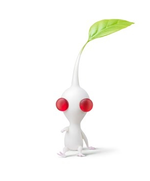
- Main article: White Pikmin.
White Pikmin are smaller than normal Pikmin and have red eyes. These Pikmin are resistant to poison. They seem to also be naturally poisonous, as enemies take heavy damage when they ingest White Pikmin. Their red eyes seem to make it possible for them to detect things buried underground and begin to dig them up. These Pikmin are also the fastest, and carry objects much quicker than other Pikmin. White Pikmin have pink flowers.
Rock Pikmin
- Main article: Rock Pikmin.
Rock Pikmin first appear in Pikmin 3. Unlike most Pikmin types, they do not have a humanoid appearance, but rather are shaped like an irregular hunk of rock and have indigo flowers. Rock Pikmin are capable of causing damage to certain types of hard obstacles and enemies that cannot be damaged by other Pikmin. They are immune to being crushed and skewer attacks.
Winged Pikmin
- Main article: Winged Pikmin.
Winged Pikmin first appear in Pikmin 3, revealed in Nintendo Direct on 17th April 2013[1]. They are pink with large blue eyes, which are similar to those of White Pikmin, and have indigo flowers like Rock Pikmin. They possess insect-like wings, and have the ability to hover over obstacles and carry objects over water. Their attack is slightly weaker than other Pikmin and will fly upwards when thrown, reaching targets that even Yellow Pikmin cannot. Winged Pikmin are immune to most ground-based attacks and enemies. However, if knocked onto the ground and stunned, they become vulnerable to said attacks.
Bulbmin
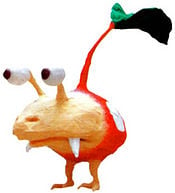
- Main article: Bulbmin.
Bulbmin are a combination of a parasitic Pikmin and a juvenile Bulborb. They are immune to all natural hazards thanks to the Bulborb's anatomy. Although they can carry objects and flower as normal Pikmin do, they are weak in battle and unable to leave the caves in which they are found. The actual appearance of the parasitic Pikmin alone is unknown.
Mushroom Pikmin
- Main article: Mushroom Pikmin.
Mushroom Pikmin are not a separate species, but rather the result of allowing Pikmin to be exposed to the spore cloud attack from a Puffstool. Pikmin affected by the cloud turn purple, grow mushrooms on their heads and turn against Olimar and other unaffected Pikmin. Mushroom Pikmin can be cured by shaking them off Olimar, by attacking one with an unaffected Pikmin, by defeating the Puffstool, or simply waiting for the effect to wear off. Both Mushroom Pikmin and the Puffstool are found only in Pikmin.
Mushroom Pikmin can sometimes turn against the Puffstool due to a certain glitch, and can sometimes even be controlled by Olimar, depending on exactly how the glitch is carried out.
Undiscovered species
| The Pikmin ending. Click [show]. |
|---|
If the player gathers every ship part in the first Pikmin game, they will see several different colors of Onions. These include purple, orange, black, pink, green, and cyan. Although Purple Pikmin were discovered in Pikmin 2, they were introduced without an Onion. Therefore, it is currently unknown whether the rest of these colors will appear in future games, or if they exist solely to add aesthetic value to the ending cinematic.
Extinction
Pikmin Extinction occurs when every single Pikmin, including those planted in the ground and stored in the Onions, is lost. The day ends immediately and the Onions each produce a single seed at the beginning of the following day.
In Pikmin, the following is Olimar's Journal entry on the first day extinction occurs: The Pikmin have all perished because of my own carelessness. I am an utter disgrace as a leader... How can I continue to collect parts without them? Still the Onions join me in low orbit, as if this Pikmin extinction had never happened. I shan't sleep tonight...
Habits
Pikmin following leaders are prone to stumbling every now and then, and occasionally fall over completely, in both Pikmin games. This happens much more frequently in Pikmin, and, further complicated by a mass of 100 Pikmin walking together, can sometimes pose a serious problem, reducing general maneuverability. In Pikmin 2, Pikmin trip much less frequently, but still stumble often if directed to switch positions suddenly. During a retreat from a beast, a Pikmin that trips is likely to be eaten or squashed by the creature; this is especially aggravating during zero death runs. Sometimes, it may be hard to notice if a Pikmin trips, leading to lone Pikmin becoming separated from the group.
Pikmin can be seen interacting with each other when idle. These actions include grooming each other, communicating in high pitched whimpers, waving, and playing abstract games. In Pikmin 2, if 20 of each type Pikmin is called into one group, they will hum a portion of the song Ai no Uta, which at one point topped the sales of the game it was created solely to advertise: Pikmin. This suggests that they have a highly developed and friendly social structure. Pikmin will also watch captains move around when stationary, indicating that they are very curious creatures, and can be seen to mimic the idle motions of those leaders. All idle Pikmin have a natural tendency to perform nearby tasks, such as, for Blue Pikmin, running into water to save drowning Pikmin, even if it is infested with enemies.
Melee Trophy Description
The 'Pikmin' trophy in Super Smash Bros. Melee reads as follows:
These strange beings are part plant, part animal. They spend most of their time buried in the earth, but they will befriend whoever plucks them, as evidenced by their devotion to Captain Olimar. Each Pikmin has a leaf on its head that grows into a bud and finally a flower. Like a flower, the life of a Pikmin is both fragile and beautiful.
Gallery
- Pikmin3Promo4.png
Alph leading the Pikmin away from a Red Bulborb.
See also
References
| Pikmin | |
|---|---|
| Types | Red Pikmin • Yellow Pikmin • Blue Pikmin • Purple Pikmin • White Pikmin Rock Pikmin • Winged Pikmin • Ice Pikmin • Bulbmin • Glow Pikmin |
| Biology | Candypop Bud • Idle • Maturity • Onion • Flarlic • Pellet Pikmin extinction • Trip • Sprout • Seedling • Soul • Squad |
| Abilities | Carry • Dig • Dodge • Fight • Hide |
| Controls | Charge • Dismiss • Swarm • Pluck • Throw • Whistle |
| Other | Decor Pikmin • Leafling • Mushroom Pikmin • Pikpik carrot |

